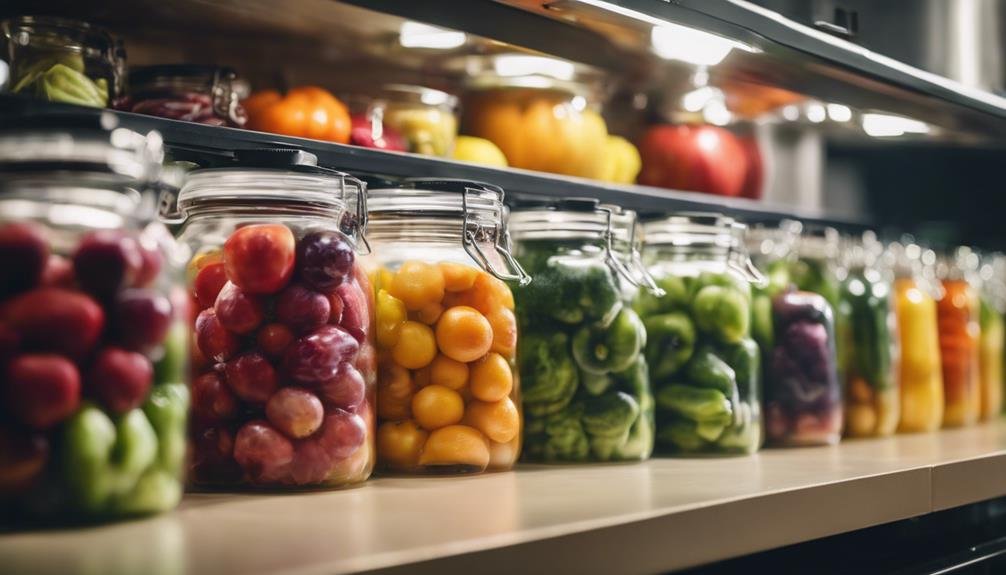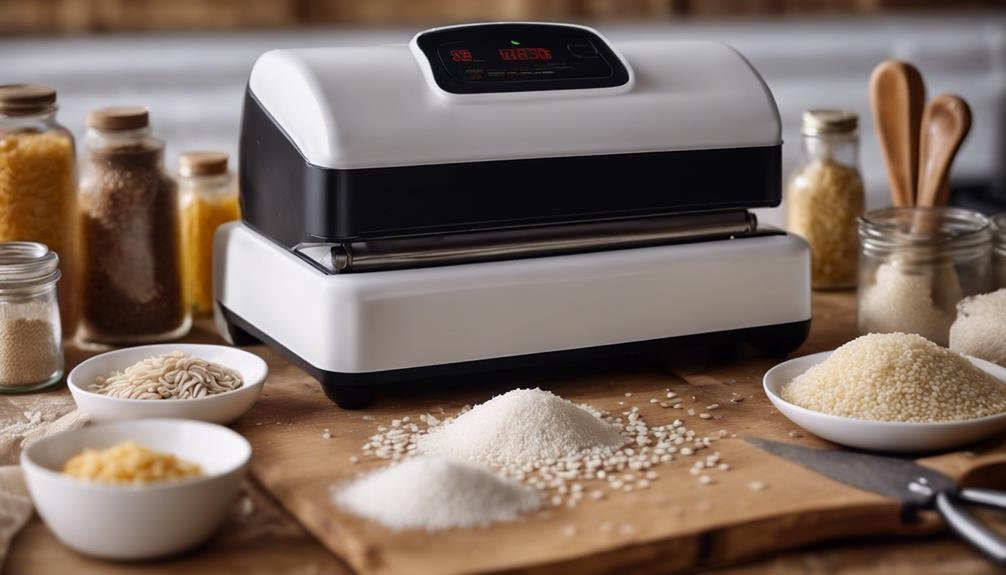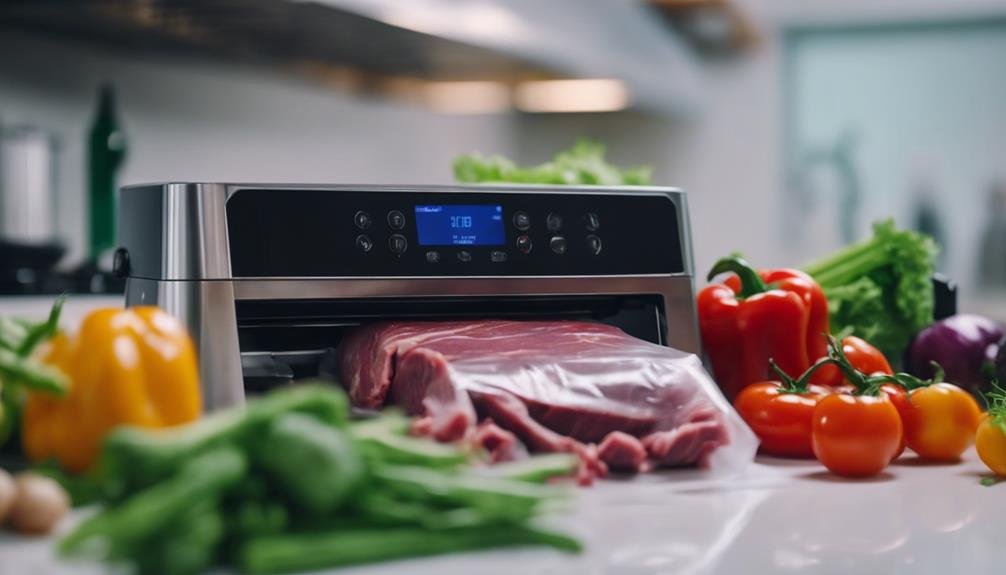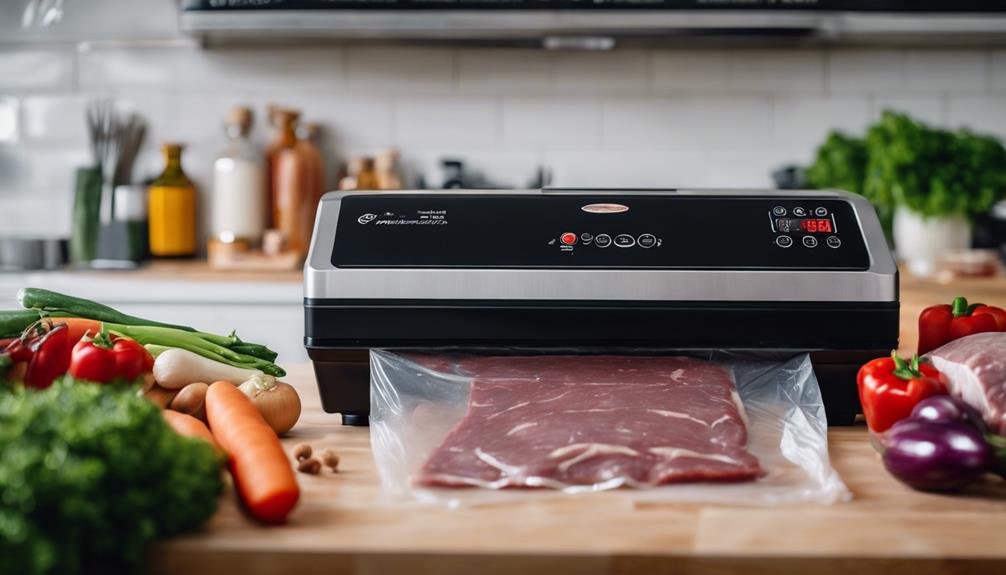For effective long-term vacuum sealing, it's crucial to use specialized heat-seal bags designed for this purpose. When preparing the bags, remember to leave some space at the top for proper sealing. Before filling the bags, fold the top edge to ensure a secure seal. Avoid reusing bags that previously stored meats or seafood to prevent cross-contamination.
When vacuum sealing fruits and vegetables, start by washing and drying them thoroughly. For fruits, it's helpful to freeze them beforehand to preserve their freshness. As for vegetables, blanching them before sealing can help maintain their texture and color over time. Dry goods should be stored in airtight containers to prevent exposure to air and moisture.
Invest in high-quality vacuum sealers and accessories to safeguard valuable items like emergency supplies and important documents. This technique effectively protects against damage from air and moisture, ensuring the longevity of your stored items. Are you ready to optimize the benefits of vacuum sealing in your everyday life?
Benefits of Vacuum Sealing
Vacuum sealing often preserves food freshness and taste by removing air from the packaging. By using vacuum sealers, you can greatly extend the shelf life of your groceries, sometimes by up to five times. This food preservation technique not only keeps your ingredients fresh but also helps in preserving food and extending its usability. Imagine having beef or poultry that can last up to three years—it's a game-changer for anyone looking to save time and money.
One of the major benefits of vacuum sealing is that it helps prevent freezer burn. When you remove air from the packaging, you're reducing the risk of your food getting those unpleasant ice crystals. Another advantage is the space efficiency. Vacuum-sealed food takes up less space in your refrigerator or freezer, making it easier to organize and store more items.
Additionally, vacuum sealing is fantastic for meal prepping and bulk buying. It allows you to portion out your meals and store them efficiently. Plus, if you enjoy cooking sous vide style, vacuum sealing is essential. You can even infuse foods with marinades before sealing, enhancing flavors without the need for additional steps later. With Vacuum Sealed Food, your culinary possibilities are endless.
Essential Vacuum Sealing Tips
To make the most of vacuum sealing, follow these essential tips to guarantee your food stays fresh and safe. First, always leave some space at the top of vacuum sealing bags. This ensures a proper seal and helps prevent liquids from being sucked into the machine. If you're looking to reduce waste, consider using vacuum sealing rolls. These rolls let you create custom-sized bags tailored to different items, making the process more efficient.
Using specialized heat-seal bags is important. These bags are designed specifically for vacuum sealing, helping to maintain freshness and prevent air leakage. Before you start filling any bag, fold the top edge over. This simple step keeps the sealing area clean and ensures an effective seal every time.
To prevent cross-contamination and adhere to food safety standards, avoid reusing bags that previously stored meats or seafood. These items can leave behind bacteria, making it safer to use a fresh bag.
Sealing Fruits and Vegetables

Properly sealing fruits and vegetables guarantees they retain their freshness and nutritional value for a longer period. By vacuum sealing, you can greatly extend the shelf life of your produce. Start by washing and drying your fruits and vegetables to remove any dirt or residue. This step is vital for maintaining freshness and ensuring effective preservation.
For fruits like berries, you'll want to freeze them first. This step prevents them from getting crushed during the vacuum sealing process, preserving their texture and color. When it comes to vegetables, blanching is an important step to keep in mind. Although we'll cover blanching in more detail later, it's crucial to know that it helps preserve the color and texture of vegetables like broccoli, carrots, and peas before vacuum sealing.
Vacuum sealing is a fantastic way to maintain the long-term freshness of your produce. The reduced oxygen environment helps keep the vibrant color and crisp texture of your fruits and vegetables intact. Plus, it effectively prevents spoilage and waste, making your grocery efforts more efficient and cost-effective. With these simple steps, you can enjoy the benefits of vacuum sealing and ensure your fruits and vegetables remain fresh and flavorful for much longer.
Blanching Vegetables for Freezing
Blanching vegetables before freezing is an important step that guarantees they retain their vibrant color, flavor, and texture. When you blanch vegetables, you briefly cook them in boiling water or steam. This process helps preserve their nutrient content and ensures they freeze well. After blanching, you need to plunge the vegetables into ice water. This stops the cooking process immediately and locks in their freshness.
It's essential to follow precise blanching times for each type of vegetable. Different vegetables require different times to achieve the best quality. Over-blanching or under-blanching can negatively impact the vegetables' texture and flavor. For instance, leafy greens might need just a couple of minutes, while denser vegetables like carrots could need a bit longer.
Preserving Dry Goods

Vacuum sealing dry goods is a simple yet effective way to extend their shelf life and maintain their quality. When you vacuum seal items like flour, sugar, and spices, you can extend their shelf life by up to two years. This method helps keep your pantry staples fresh, free from pests, and protected from moisture.
By eliminating air and moisture, vacuum sealing helps prevent staleness and preserves the flavor and texture of your dry goods. You'll find that your pantry staples taste just as good months later as they did when you first bought them. Plus, vacuum sealing is a cost-effective way to reduce food waste, allowing you to buy in bulk without worrying about spoilage.
To get the best results, make sure you use appropriate containers or vacuum-seal bags designed for dry goods. These containers will help maintain the vacuum and keep your food sealed tight. By taking these steps, you make certain that your pantry remains stocked with high-quality, long-lasting ingredients. Not only does this save you money, but it also guarantees that you always have fresh ingredients on hand when you need them.
Sealing Liquids and Moist Foods
When sealing liquids and moist foods, it's important to take extra steps to guarantee a tight seal and prevent spillage. This ensures your food remains fresh and uncontaminated. Here are some practical tips to help you succeed:
- Freeze First: For liquids like broth or marinades, freeze them before vacuum sealing. This prevents spillage and makes the process smoother.
- Use Specialized Bags: For moist foods such as fresh fruits, marinated meats, or saucy dishes, opt for specialized vacuum seal bags designed to handle the extra moisture.
- Prep the Sealing Area: Always remove excess moisture from the sealing area. This helps create a secure seal, which is important for preventing freezer burn and extending shelf life.
- Bottle Stoppers for Liquids: When dealing with liquids like wine, soups, and sauces in glass bottles, use a bottle stopper accessory to vacuum seal them effectively.
Vacuum-Sealed Cooking Techniques

Using vacuum-sealed cooking techniques, you can achieve perfectly cooked, flavorful dishes with ease and precision. By using a vacuum sealer, you remove air from vacuum-sealed bags, which is essential for sous vide cooking. This method allows for precise temperature control, resulting in evenly cooked meals that retain their natural juices and flavors.
Sous vide cooking is a popular method for preparing a variety of foods, including meats, vegetables, and even desserts. The vacuum-sealed bags lock in moisture and flavor, ensuring your dishes are always delicious. Additionally, this technique is ideal for meal prepping. You can prepare dishes in advance and store them in the fridge or freezer for longer storage periods without losing quality.
When you vacuum-seal your ingredients, you're setting yourself up for success. The vacuum sealer helps remove air, which prevents oxidation and spoilage, keeping your food fresh longer. This means you can enjoy restaurant-quality meals at home, anytime. Vacuum-sealed cooking is not only convenient but also a game-changer for anyone looking to enhance their culinary skills and streamline their kitchen routine.
Preserving Nonfood Items
You can greatly extend the lifespan of nonfood items by vacuum sealing them to protect against air and moisture damage. This method helps preserve various valuables, ensuring they stay in excellent condition for longer periods. Whether it's emergency supplies, electronics, collectibles, or important documents, vacuum sealing keeps them safe from moisture damage and the elements.
Here are some benefits you'll enjoy by vacuum sealing nonfood items:
- Preserve Valuables: Keep silver items free of tarnish and scratches, ensuring they maintain their quality and appearance.
- Protect Emergency Supplies: Safeguard items from potential flooding or outdoor elements, making sure they're ready when you need them most.
- Sustainable Practice: Reduce waste and energy consumption by extending the life of your items, promoting environmental responsibility.
- Versatile Storage: Use accessories like jar sealers to vacuum seal various types of containers, securely storing an array of nonfood items.
Choosing the Right Vacuum Sealer

Choosing the appropriate vacuum sealer is essential to guarantee your items are effectively protected and preserved. First, consider whether you need a countertop or handheld vacuum sealer. Countertop models are robust and great for frequent use, while handheld sealers are portable and ideal for smaller tasks.
Look for features like roll storage and cutter bars, which add convenience by allowing you to customize bag sizes. When selecting bags, make sure they are durable, freezable, and microwave-safe to handle various storage and reheating needs.
Also, think about the accessories. Jar sealers and bottle stoppers expand your sealing options, letting you preserve liquids and other items in different containers. This flexibility can be a game-changer for efficient storage.
Ensure your vacuum sealer can perform effective sealing even without vacuuming when necessary. This feature is important for items that don't require air removal but still need a secure seal.
Sustainable Vacuum Sealing Practices
Opt for vacuum sealing in jars to minimize plastic waste and promote sustainability. Using mason jars with the right accessories offers an environmentally friendly way to store your food. This method not only helps in plastic waste reduction but also extends the shelf life of your food items, leading to significant food waste reduction.
Here are four reasons why vacuum sealing in jars is a great idea:
- Environmentally Friendly: By using reusable mason jars, you cut down on single-use plastics, making a positive impact on the environment.
- Extended Shelf Life: Vacuum sealing in jars protects your food from moisture and air, keeping dry goods like rice, beans, and spices fresh for longer periods.
- Cost-Effective: Investing in jar sealers and accessories like canning lids pays off in the long run as you save money by reducing food spoilage and waste.
- Versatility: Mason jars come in various sizes and can store different types of pantry staples, making them a versatile option for long-term storage.
Conclusion
Think of vacuum sealing as a time capsule for your food and valuables. Just like how a ship's log preserves voyages for future generations, vacuum sealing keeps your items fresh and ready to use. By following these techniques, you're not just storing food; you're safeguarding memories and future meals. Remember, the right tools and methods make all the difference. So, start sealing today and make every meal a flavorful journey back in time.
